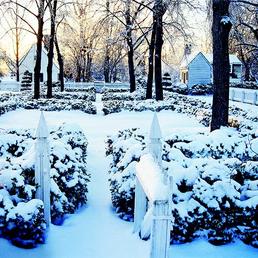 Gardeners in snowy regions have plenty of reasons to get cold feet about winter: Plants are at rest and their brightcolors dissipate, leaving a palette of white and gray. And with nothing to plant, they might think there are few winter landscaping tips -- or to dos. In fact, careful planning in spring, summer, and fall -- plus a few easy accents during winter -- can lead to a beautiful landscape that shines against the stark relief of the restful season. "If you want to be sure you have some winter interest in your garden, you are really looking at just a few things," says Barbara Pierson, nursery manager at White Flower Farm in Litchfield, Connecticut. Here are Pierson's six winter landscaping tips to make you love your yard in every season. 1. Focus on bark. Sure, deciduous trees lose their leaves in wintertime, leaving their branches and trunks in focus. But that can be a good thing, Pierson says, "if you have any interesting ornamental trees that have really visually distinctive bark, which will end up adding winter interest." Many of those trees and some shrubs are smaller, meaning they're easier to find spots for in the winter landscape. A few of Pierson's favorites include dogwoods and birch trees, great for both texture and color.  2. Include berries. Many trees and shrubs have berries they hold onto during fall and winter, and those can provide food for birds overwintering in your area. "Crabapples hold their little fruit," Pierson says, and they make a great addition to the winter landscape. "A holly with berries is really beautiful," she says.  3. Remember evergreens. Evergreens are great in the winter landscape for many reasons. First, there's color: Evergreens are not just green; they're available in yellow, such as Gold Thread false cypress, and blues, including dwarf blue spruce, and all colors in between. And evergreens just make good design sense, Pierson says. "They are really important for a winter landscape, but they make good focal points all year-round," she says. "I always like to have at least one or two evergreens and work a border around those. When you are planting a new bed, you always want to have at least one evergreen."  4. Rely on your hardscape. Winter is a good time to critically assess your landscape, figuring out where it's missing focal points. The solution to enhancing your winter landscaping might not be a plant at all. "Winter is the best time to consider hardscape," Pierson says. "A trellis, a bench, an arbor, even a garden sculpture are really essential."  5. Adorn your summertime containers. Window boxes, hanging baskets, winter-hardy containers: All are indispensable for winter landscaping. Miniature dwarf Alberta spruce and broadleaf evergreens, such as Japanese Andromeda, holly and rhododendron, are perfect for wintertime, but they all have to be watered during dry periods. You don't have to spend money on plants, Pierson says. "Fill containers with evergreen boughs of different textures and colors and interesting twigs," she says, "anything with color in it."  6. Stick with four-season perennials. Some perennials have evergreen foliage -- ornamental grasses, hellebores, even dianthus with its beautiful low-creeping foliage -- making them great for winter landscaping, Pierson says. "Make sure to read the plant label and find out if the plant has foliage in the winter, so you can see it year-round," she says. Winter is also a great time to stock up on the nonplant elements you'll need for the next year's garden, Pierson says. "It's a good time to bargain-shop for anything for the garden," she says. Take a tape measure, research plants, figure out seeds you'll need, and write down what worked and what didn't in the current year.
0 Comments
Leave a Reply. |
Archives
June 2016
Categories
All
|
 RSS Feed
RSS Feed
